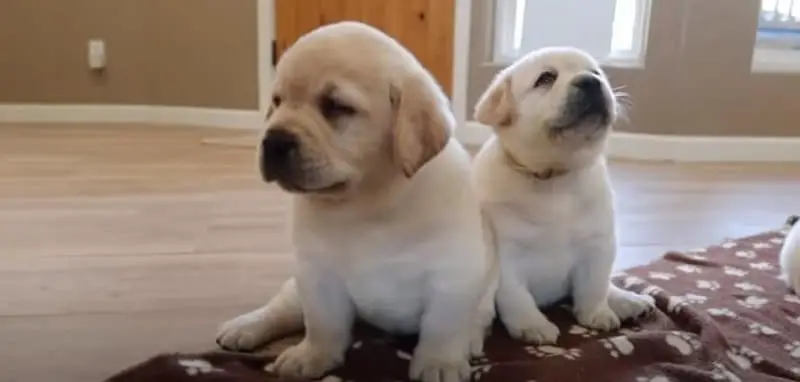So, you found a perfect breeder, have prepared your house and family for its new member, and are ready to pick a puppy to bring home. What should you look for, and what will the first days and weeks with your new puppy look like?
When choosing a puppy from its siblings, the important things to consider are whether it has a well-balanced structure, clear eyes and ears, and moves well. Both size and disposition will change as a puppy grows up, but these early signs of physical health largely remain.
In this article, you will learn what to look for when selecting your pick of the litter. We will also talk about making the first days and weeks as easy as possible for you and your lab.
Table of Contents
Does the Size of the Puppy Matter?
It matters less than you might think whether a puppy is the biggest or smallest in its litter! Of course, things like these will shape how a puppy behaves in its first weeks.
Smaller puppies will often play a submissive role in their litter, whereas bigger ones tend to be more confident and dominant.
At this early age, their character is not yet fixed, though, and it makes a big difference in what kind of family they find themselves in after being adopted.
A big, boisterous puppy can learn to be well-behaved, and a small, timid one can quickly gain confidence.
The size of puppies that are just a few weeks old is also not indicative of how big they will be when they have finished growing.
While they are still in their litter, the internal hierarchy will decide which puppy gets to eat first and wait for what is left. Smaller puppies often have to have harder at the beginning and fight for a place at the table.
This can highly influence puppies’ disposition, growth, and weight while they are still in their litter at the breeder’s. Nevertheless, the parents’ size is much more indicative of how large your lab puppy will be when it is fully grown!
For this reason, it makes more sense to look at the body structure of a puppy since this will largely remain unchanged throughout its life.
How Does a Good Body Structure Look Like in A Lab Puppy?
Overall, you should look for a balanced look with legs that are parallel – bow legs or knock knees will lead to shoulder injuries and joint problems early on.
Since Labradors are prone to joint problems anyway, you will want to make sure that your puppy does not have an even higher propensity for this kind of health problem.
The neck should not be too short since a nice and long neck is better for a lab’s forward movement. Especially if you want to train your lab as a hunting dog, the muzzle should not be too short either, since then it will not be able to carry large birds in its mouth, which is a labrador’s main function as a working dog.
Your puppy should display a scissor bite, which means that the incisor teeth in the upper jaw slightly overlap those in the lower jaw.
Some puppies display even bites or underbites. While an even bite can grow out when the head grows, this rarely happens with an underbite.
When it comes to Labradors, which were originally bred as working dogs, the form very much follows the function.
This means that their body structure is uniquely designed to help them fulfill their job of retrieving game or fowl, with all the leaping over branches or streams that comes with it.
Of course, when you want your puppy simply as a pet or trained as a companion dog, these are completely different purposes from gundogs, which means that some of these aspects of body structure are not that important for your personal goals.
Nevertheless, you should keep in mind that their body structure is important for retrieving and that flaws in a body structure can also lead to health problems.
A responsible breeder will have had both parents of a litter tested for hereditary health problems so that you can make an informed decision.
While a predisposition for illness does not make a less loving and loyal pet out of your lab puppy, it will take a more experienced dog owner who can spend a lot of money on vet bills to manage caring for a lab like this.
What Do The First Days With My New Labrador Puppy Look Like?
However much you have looked forward to this moment, it cannot be denied that the first days – above all, the very first night! – after you have taken your puppy home, it will likely be very stressful for both you and your pup.
After all, the puppy has suddenly been taken away from everything it has known, whereas you introduced a new family member to your home.
When you bring your puppy home via a long car journey, the moment of your arrival is also the very moment you can start potty training your new household member.
After a long journey, your puppy will have to pee. Therefore, you have to pick the puppy up and carry it straight to the area where you want it to relieve itself – when you put them down before, they will likely relieve themselves on the spot.
In the beginning, puppies also have to pee a lot, sometimes several times an hour! They will soon manage to last longer, but you or another household member will always have to keep an eye on them in the beginning.
Always take your puppy to the same dedicated toilet area to learn what this place is for.
During the first days, puppies are also prone to upset stomachs due to the excitement of everything. This means that you should only feed very small portions spread throughout the day.
The difficulty here is to remain strong when faced with pleading puppy eyes – do not give in. Labradors are always ready to eat and will eat far more than they can stomach if you let them!
It is also good to stick to the same kind of dog food that your breeder uses so that your puppy does not have to get used to new food on top of a whole new living situation.
The very first night in its new home can be a challenge for your puppy. Some puppies are so exhausted from all the excitement of the day that they will fall asleep deeply once put to bed, but others will experience homesickness and whine and howl through the night.
If that is the case, it is recommended to keep your puppy next to your bed for the first three or four nights. In this way, you can check in when it is crying, and the puppy will not feel left alone in a strange place.
If they can smell and hear you during the night, they are less likely to cry because they know that they are not isolated.
During the first week or a few days more, puppies will also wake up for a pee during the night. While it is exhausting having to take your puppy out in the middle of the night, this is only the case at the beginning, and in a week or so, you will be able to sleep through the night again.
When Can I Start Training My Lab Puppy?

The first month in your life with a new puppy is focused on socializing the puppy and letting it bond with its new family.
This means that you should keep the puppy close, pay lots of attention and spend a lot of time with it. In this way, your lab learns to trust you and comfortably settle in, making training much easier later on.
At this stage, training usually consists of games that teach your puppy to fetch toys, pay attention to you, and get used to wearing a collar.
These playful early stages will prepare your puppy for whatever it is needed for later, be that retrieving or interacting with your children.
You can also help your puppy get used to being left alone for a short time. Start with just a few minutes so that they learn that you reliably return.
It is normal that in the beginning, your puppy will sometimes pee or poop on the floor when you have not taken it to the designated bathroom area regularly.
Getting angry is of no use here and will only work to intimidate your puppy so that it develops a nervous, anxious disposition. You should clean up the accident – praising and encouraging a puppy for doing something right are way more efficient than punishment for doing something wrong!
In this month, you should take your puppy to meet all kinds of different people of different sizes and behaviors. It also helps your puppy get used to the sounds of smells of vehicles, other animals, and anything else that it will encounter regularly.
This will help your puppy feel confident and safe in the human world, and a dog that feels safe does not bite or act erratically.
After the first month, you can begin with more complex and specific training, like moving to sit and stay and walking on a leash.
Training a labrador is a life-long process, and you will always add complexity and challenges to the training. At the very beginning, basic household manners and being well-behaved and confident in public are way more important than performing impressive tricks. There will be enough time for all this later on.
Table Of Contents
